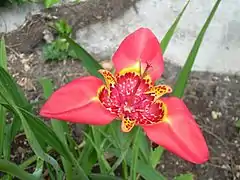| Tigridia pavonia | |
|---|---|
 | |
| A yellow-flowered form | |
| Scientific classification | |
| Kingdom: | Plantae |
| Clade: | Tracheophytes |
| Clade: | Angiosperms |
| Clade: | Monocots |
| Order: | Asparagales |
| Family: | Iridaceae |
| Genus: | Tigridia |
| Species: | T. pavonia |
| Binomial name | |
| Tigridia pavonia | |
| Synonyms[2] | |
|
List
| |
Tigridia pavonia is a species of flowering plant in the iris family Iridaceae. Common names include jockey's cap lily,[3] Mexican shellflower,[4] peacock flower,[4] tiger iris,[5] and tiger flower.[4] This summer-flowering bulbous herbaceous perennial is widespread across much of Mexico, Guatemala, El Salvador, and Honduras. It is naturalized in Ecuador and Peru.[4][6]
The leaves are narrow and lance-shaped. The three-petalled blooms occur in a variety of colours with strongly contrasting central markings.[7] They open early in the morning and close before dusk. Blooms are successional throughout summer. Plants bloom in the first year after sowing.
Tigridia pavonia is cultivated as an ornamental plant. It prefers a sheltered position in full sun, in sandy but fertile soil. As it is only hardy to 5 °C (41 °F), in colder areas bulbs should be lifted and stored throughout the winter months.[7]
The roasted bulbs are edible and have been used by the American Indians and Indigenous peoples of Mexico. It has a chestnut-like flavour.[5]
The aphid Aphis newtoni may be found on this plant.[8]
References
- ↑ "Tigridia pavonia". International Plant Names Index (IPNI). Royal Botanic Gardens, Kew; Harvard University Herbaria & Libraries; Australian National Botanic Gardens. Retrieved 2 August 2021.
- ↑ "Tigridia pavonia". World Checklist of Selected Plant Families. Royal Botanic Gardens, Kew – via The Plant List. Note that this website has been superseded by World Flora Online
- ↑ Books, M.; Limited, M.B.P. (2004). Growing Bulbs. Murdoch Books. ISBN 9781740455206.
- 1 2 3 4 "Tigridia pavonia". Germplasm Resources Information Network. Agricultural Research Service, United States Department of Agriculture. Retrieved 16 January 2014.
- 1 2 Alan Davidson The Oxford Companion to Food, p. 116, at Google Books
- ↑ Kew World Checklist of Selected Plant Families
- 1 2 "Tigridia pavonia". RHS. Retrieved 28 July 2021.
- ↑ Proceedings of the Estonian Academy of Sciences, Biology and Ecology June 2002 Proceedings of the Estonian Academy of Sciences, Biology and Ecology June 2002, p. 128, at Google Books


